United States Coast Guard 2 (2/7)
Aids to Navigation
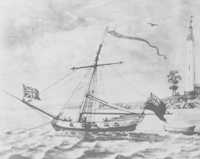
Right: an early engraving of the Boston Lighthouse
One of the first acts of the young federal government was to provide for aids to navigation. On 7 August 1789, the First Congress federalized the existing lighthouses built by the colonies and appropriated funds for lighthouses, beacons, and buoys. Lighthouses generally reflect the existing technology of the time they were built. Each is also unique because their specific sites required special considerations. The earliest Colonial and Federal lighthouses were built of stone and had walls up to seven feet thick. Later advances allowed even taller structures made of brick. Screw-pile structures, reinforced concrete towers, steel towers, and caisson structures all added to the rich and unique architecture.
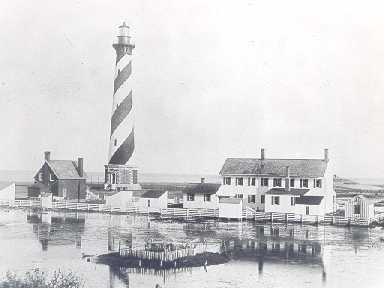
Right: Cape Hatteras Light Station, 1898
There have been more than 1,000 lighthouses built and they provided the main guidance to mariners into the main harbors of the United States. For the first five decades, there existed little bureaucracy, no tenders, only the lone keepers who kept the lights burning. The administration of the lighthouses bounced from the Treasury Department to the Commerce Department and was transferred to the Coast Guard in 1939.
While many of the lighthouses have changed little since their completion, the light sources have continually evolved to provide mariners with better guidance. Some of the earliest optics were multiple-wicked oil lamps with reflectors to concentrate the light. The French physicist Augustin Fresnel revolutionized the optics of lighthouses by inventing a lens with annular rings, reflectors, and reflecting prisms that all surrounded a single lamp. These lenses proved to be so effective that many are still in use today providing safe roads for maritime travelers

Right: a clamshell-type Fresnel lens
Sound has also been used to guide ships. In colonial times cannons fired on shore warned ships away from land during fog. Improvements to the sound of gunfire followed. A fog bell first went into use in 1852, followed by a mechanical striking bell in 1869, a fog trumpet in 1872, and an air siren in 1887.
The men and women of the Lighthouse Service were among the most dedicated in government service. They frequently performed their duty in extreme hardship. Abbie Burgess served 38 years in lighthouses. Stationed at the Matinicus Rock and White Head Light Stations in Maine, she dutifully served while simultaneously caring for her family. Keepers were also cited many times for saving lives in shipwreck disasters.
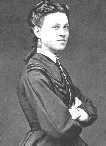
Ida Lewis (right) saved 18 lives during her 39 years at the Lime Rock Lighthouse and Marcus Hanna the keeper of the Cape Elizabeth Light is probably the only man in history to have won both the Medal of Honor and the Gold Lifesaving Medal. Other acts of the service of keepers are inspiring. Indians attacked the Cape Florida Lighthouse and set it on fire. The keeper escaped with his life only after throwing a keg of gunpowder down the burning tower. Other keepers died on duty, being swept away in storms. The 1906 hurricane destroyed 23 lights along the Gulf Coast killing the keepers at Horn Island and Sand Island. An earthquake caused a tsunami in Alaska that killed the crew of the Scotch Cap Lighthouse (below right) in 1946.
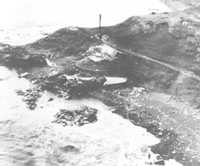
With the emergence of new technologies, like the Global Positioning System (GPS), in the latter part of the 20th century, lighthouses became obsolete and many light stations were decommissioned and transferred to other agencies or private individuals. As a result, there is only one Coast Guard-manned light station remaining in the United States, Boston Harbor.
Though lighthouses are being decommissioned and transferred, the Coast Guard still must tend to other short-range aids to navigation like buoys and markers. As a result, the service began replacing its aged 180-foot buoy tender fleet with the new 175-foot "Keeper"-class (coastal) tenders and 225-foot Juniper-class (seagoing) tenders. The lead vessel in this class was Ida Lewis which was delivered to the Coast Guard on 1 November 1996. These new cutters should ably tend aids to navigation and meet other USCG mission requirements well into the 21st century.
Lightships

Right: LV-91, circa 1908
Lightships served to guide mariners where there was a need for a light but in a spot where lighthouses could not be placed. There have been over 120 lightship stations along the coast of the United States. The Lighthouse Service placed the first lightship in the Chesapeake Bay in 1820. Hundreds of lightships have served along the coasts and usually in extremely exposed anchorages. The vessels carried virtually the same aids to navigation as lighthouses and lasted until 1983 when the Nantucket Lightship was replaced by a Large Navigational Buoy [LNB].
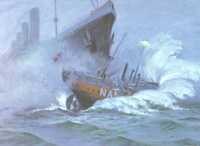
Both storms and ships have taken their toll on lightships. Hurricanes have sunk and blown many lightships from their stations, while vessels passing through busy sea lanes have collided with and sunk these floating aids. One of the deadliest collisions occurred on 16 May 1934. The 45,000 ton Olympic, sister of the ill-fated Titanic, struck and sank the Nantucket Shoals Lightship, LV-117. (right) the liner approached the port of New York in fog and struck and drove the lightship to the bottom with the loss of seven of her eleven crewmen.

